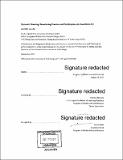Dynamic drawing : broadening practice and participation in procedural art
Author(s)
Jacobs, Jennifer (Jennifer Mary)
DownloadFull printable version (23.29Mb)
Alternative title
Broadening practice and participation in procedural art
Other Contributors
Program in Media Arts and Sciences (Massachusetts Institute of Technology)
Advisor
Mitchel Resnick.
Terms of use
Metadata
Show full item recordAbstract
Computation is a powerful medium for art creation. Procedural art, or artwork defined by a computationally represented system of rules, relationships, and behaviors, enables creation of works that are flexible, adaptable, and capable of systematic revision. Yet the medium for creating procedural art, computer programming, can pose significant barriers for manual artists. Programming can be challenging to learn, and programming tools can restrict the concrete practices of manual art. An analysis of the creative opportunities of procedural art and the conflicts programming poses for manual artists raises these questions: (1) How can we create procedural art systems that are accessible and expressive for manual artists? (2) How can we support different ways of thinking and creating with representational mediums? (3) How can procedural art systems contribute to the process of learning and understanding representational mediums? This dissertation explores these questions through two new systems that integrate manual and procedural creation. Para is a digital illustration tool that enables artists to produce procedural compositions through direct manipulation. Dynamic Brushes is a system that enables artists to create computational drawing tools that procedurally augment the process of manual drawing. Para and Dynamic Brushes were informed through interviews with artists and evaluated through multi-week open-ended studies in which professionals created polished artwork. These evaluations provided a framework for developing creative tools through extended work with creative professionals. Comparison of artwork produced with Para and Dynamic Brushes revealed specific trade-offs in expressiveness, ease of entry, and working style for direct manipulation and representational procedural tools. Overall, this research demonstrates how integrating manual and procedural creation can diversify the kinds of outcomes people can create with procedural tools and the kinds of people who can participate in procedural art.
Description
Thesis: Ph. D., Massachusetts Institute of Technology, School of Architecture and Planning, Program in Media Arts and Sciences, 2017. Cataloged from PDF version of thesis. Includes bibliographical references (pages 145-155).
Date issued
2017Department
Program in Media Arts and Sciences (Massachusetts Institute of Technology)Publisher
Massachusetts Institute of Technology
Keywords
Program in Media Arts and Sciences ()